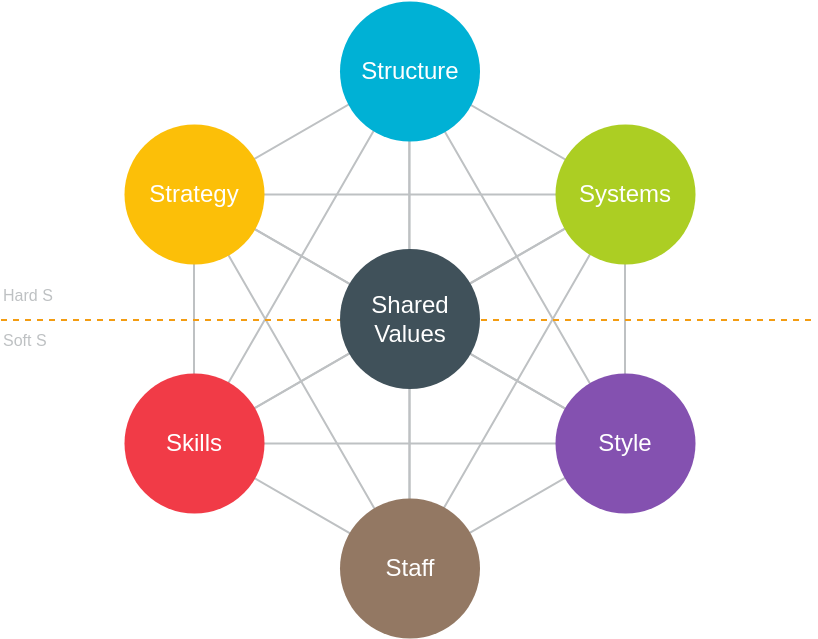The McKinsey 7-S Framework is a strategic management tool that helps organizations analyze their internal design and effectiveness. This framework suggests that there are seven key elements within an organization that need to be aligned and mutually reinforcing for the organization to be successful. These seven elements are:

- Shared Values: The core values and beliefs that the organization and its members share.
- Strategy: The plan that an organization has to achieve its goals and objectives.
- Structure: The way the organization is structured and organized, including its reporting lines, decision-making processes, and division of responsibilities.
- Systems: The processes, information flows, and feedback mechanisms that the organization uses to operate on a day-to-day basis.
- Style: The leadership and management styles that are practiced within the organization.
- Staff: The people who work for the organization, their skills, competencies, and development.
- Skills: The distinctive capabilities that the organization possesses and that set it apart from its competitors.
The key benefit of the McKinsey 7-S Framework is that it provides a holistic view of an organization, recognizing that these seven elements are interconnected and must be aligned for the organization to be effective. By analyzing these seven elements, organizations can identify areas of strength and weakness, and develop strategies to improve their overall performance.
The 7-S Framework is particularly useful when:
- Implementing a new strategy or structure: The framework can help ensure that all elements are aligned and support the new direction.
- Merging organizations: The framework can help identify areas of synergy and potential conflicts that need to be addressed.
- Diagnosing organizational problems: By analyzing the seven elements, the framework can help pinpoint the root causes of issues and guide the development of solutions.
- Improving organizational effectiveness: The framework can be used to assess the current state of the organization and identify areas for improvement.
To use the McKinsey 7-S Framework, organizations typically follow these steps:
- Gather data: Collect information about the seven elements through interviews, document reviews, and observations.
- Analyze the data: Identify the current state of each element and assess the degree of alignment between them.
- Identify gaps and opportunities: Determine where the elements are not aligned and where improvements can be made.
- Develop a plan: Create a plan to address the identified gaps and ensure that the seven elements are aligned and mutually reinforcing.
- Implement the plan: Execute the plan and monitor the results to ensure that the desired outcomes are achieved.
The McKinsey 7-S Framework has been successfully applied in a wide range of organizations, from small businesses to large multinational corporations. By providing a comprehensive and structured approach to organizational analysis, the framework can help organizations unlock their full potential and achieve their strategic objectives.
McKinsey 7-S Framework Case Study
Here’s a comprehensive example of how the McKinsey 7-S Framework can be applied to a real-world organization:
Let’s consider the case of a leading global technology company, XYZ Corporation, which is looking to expand its presence in the healthcare sector.
- Shared Values: XYZ Corporation has a strong corporate culture that emphasizes innovation, customer-centricity, and social responsibility. These core values are deeply ingrained in the organization and guide the decision-making and behaviors of its employees.
- Strategy: XYZ’s strategy for the healthcare sector is to leverage its existing technological expertise and develop innovative solutions that improve patient outcomes and streamline healthcare delivery. The company plans to achieve this by acquiring a leading healthcare technology firm, integrating its operations, and cross-selling its products and services to the healthcare industry.
- Structure: XYZ has a decentralized organizational structure, with various business units operating relatively autonomously. To support the healthcare expansion, the company has created a new healthcare division that reports directly to the CEO and is responsible for integrating the acquired firm and driving the healthcare strategy.
- Systems: XYZ has robust information and process management systems that enable efficient data collection, analysis, and decision-making. However, the company’s legacy systems may not be fully compatible with the healthcare firm’s software, which could create integration challenges.
- Style: XYZ is known for its collaborative and innovative leadership style, which encourages employee empowerment and risk-taking. The healthcare division’s leadership team will need to adapt this style to the more regulated and risk-averse healthcare industry.
- Staff: XYZ has a highly skilled and diverse workforce, with expertise in areas like software engineering, data analytics, and product development. However, the company may need to hire more healthcare-specific talent, such as clinicians and regulatory experts, to support the successful integration and operation of the acquired firm.
- Skills: XYZ’s core competencies lie in areas like software development, cloud computing, and user experience design. The company will need to leverage these skills to create tailored healthcare solutions and seamlessly integrate the acquired firm’s capabilities.
By analyzing XYZ Corporation through the lens of the 7-S Framework, the company can identify areas of alignment and misalignment, and develop a comprehensive plan to ensure that all seven elements are working in harmony to support the successful expansion into the healthcare sector.
This example demonstrates how the 7-S Framework can be used to assess an organization’s internal dynamics and design, and guide the development of a strategic plan that aligns all critical elements for achieving the desired outcomes.













